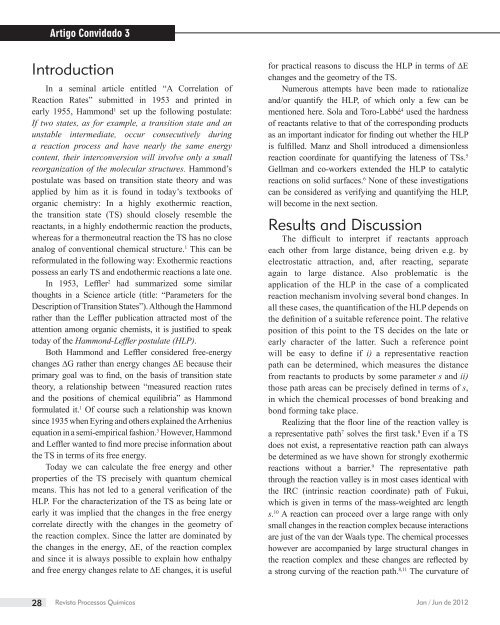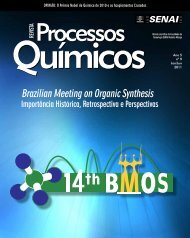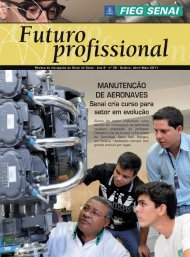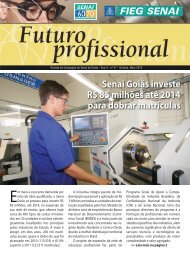Clique aqui para download - senai
Clique aqui para download - senai
Clique aqui para download - senai
You also want an ePaper? Increase the reach of your titles
YUMPU automatically turns print PDFs into web optimized ePapers that Google loves.
Artigo Convidado 3<br />
Introduction<br />
In a seminal article entitled “A Correlation of<br />
Reaction Rates” submitted in 1953 and printed in<br />
early 1955, Hammond 1 set up the following postulate:<br />
If two states, as for example, a transition state and an<br />
unstable intermediate, occur consecutively during<br />
a reaction process and have nearly the same energy<br />
content, their interconversion will involve only a small<br />
reorganization of the molecular structures. Hammond’s<br />
postulate was based on transition state theory and was<br />
applied by him as it is found in today’s textbooks of<br />
organic chemistry: In a highly exothermic reaction,<br />
the transition state (TS) should closely resemble the<br />
reactants, in a highly endothermic reaction the products,<br />
whereas for a thermoneutral reaction the TS has no close<br />
analog of conventional chemical structure. 1 This can be<br />
reformulated in the following way: Exothermic reactions<br />
possess an early TS and endothermic reactions a late one.<br />
In 1953, Leffl er 2 had summarized some similar<br />
thoughts in a Science article (title: “Parameters for the<br />
Description of Transition States”). Although the Hammond<br />
rather than the Leffl er publication attracted most of the<br />
attention among organic chemists, it is justifi ed to speak<br />
today of the Hammond-Leffl er postulate (HLP).<br />
Both Hammond and Leffl er considered free-energy<br />
changes ∆G rather than energy changes ∆E because their<br />
primary goal was to fi nd, on the basis of transition state<br />
theory, a relationship between “measured reaction rates<br />
and the positions of chemical equilibria” as Hammond<br />
formulated it. 1 Of course such a relationship was known<br />
since 1935 when Eyring and others explained the Arrhenius<br />
equation in a semi-empirical fashion. 3 However, Hammond<br />
and Leffl er wanted to fi nd more precise information about<br />
the TS in terms of its free energy.<br />
Today we can calculate the free energy and other<br />
properties of the TS precisely with quantum chemical<br />
means. This has not led to a general verifi cation of the<br />
HLP. For the characterization of the TS as being late or<br />
early it was implied that the changes in the free energy<br />
correlate directly with the changes in the geometry of<br />
the reaction complex. Since the latter are dominated by<br />
the changes in the energy, ∆E, of the reaction complex<br />
and since it is always possible to explain how enthalpy<br />
and free energy changes relate to ∆E changes, it is useful<br />
28<br />
for practical reasons to discuss the HLP in terms of ∆E<br />
changes and the geometry of the TS.<br />
Numerous attempts have been made to rationalize<br />
and/or quantify the HLP, of which only a few can be<br />
mentioned here. Sola and Toro-Labbé 4 used the hardness<br />
of reactants relative to that of the corresponding products<br />
as an important indicator for fi nding out whether the HLP<br />
is fulfi lled. Manz and Sholl introduced a dimensionless<br />
reaction coordinate for quantifying the lateness of TSs. 5<br />
Gellman and co-workers extended the HLP to catalytic<br />
reactions on solid surfaces. 6 None of these investigations<br />
can be considered as verifying and quantifying the HLP,<br />
will become in the next section.<br />
Results and Discussion<br />
The diffi cult to interpret if reactants approach<br />
each other from large distance, being driven e.g. by<br />
electrostatic attraction, and, after reacting, se<strong>para</strong>te<br />
again to large distance. Also problematic is the<br />
application of the HLP in the case of a complicated<br />
reaction mechanism involving several bond changes. In<br />
all these cases, the quantifi cation of the HLP depends on<br />
the defi nition of a suitable reference point. The relative<br />
position of this point to the TS decides on the late or<br />
early character of the latter. Such a reference point<br />
will be easy to defi ne if i) a representative reaction<br />
path can be determined, which measures the distance<br />
from reactants to products by some <strong>para</strong>meter s and ii)<br />
those path areas can be precisely defi ned in terms of s,<br />
in which the chemical processes of bond breaking and<br />
bond forming take place.<br />
Realizing that the fl oor line of the reaction valley is<br />
a representative path 7 solves the fi rst task. 8 Even if a TS<br />
does not exist, a representative reaction path can always<br />
be determined as we have shown for strongly exothermic<br />
reactions without a barrier. 9 The representative path<br />
through the reaction valley is in most cases identical with<br />
the IRC (intrinsic reaction coordinate) path of Fukui,<br />
which is given in terms of the mass-weighted arc length<br />
s. 10 A reaction can proceed over a large range with only<br />
small changes in the reaction complex because interactions<br />
are just of the van der Waals type. The chemical processes<br />
however are accompanied by large structural changes in<br />
the reaction complex and these changes are refl ected by<br />
a strong curving of the reaction path. 8,11 The curvature of<br />
Revista Processos Químicos Jan / Jun de 2012







